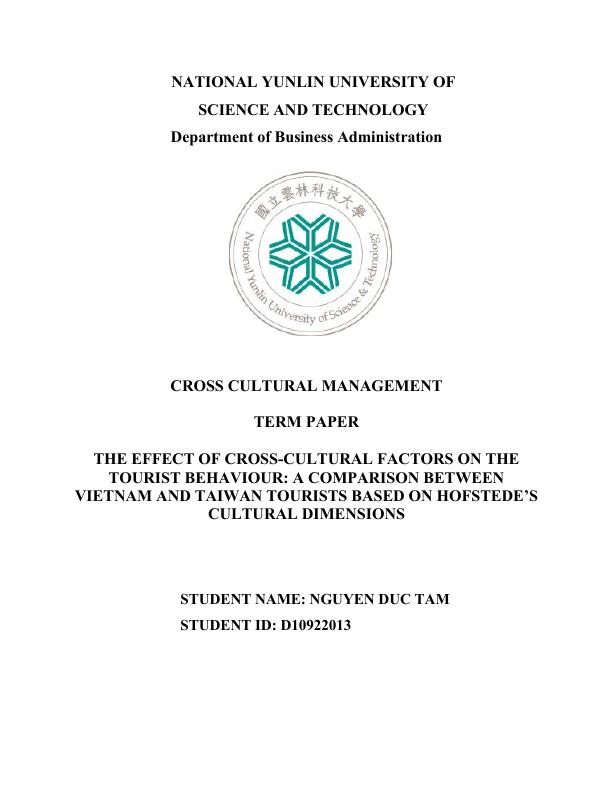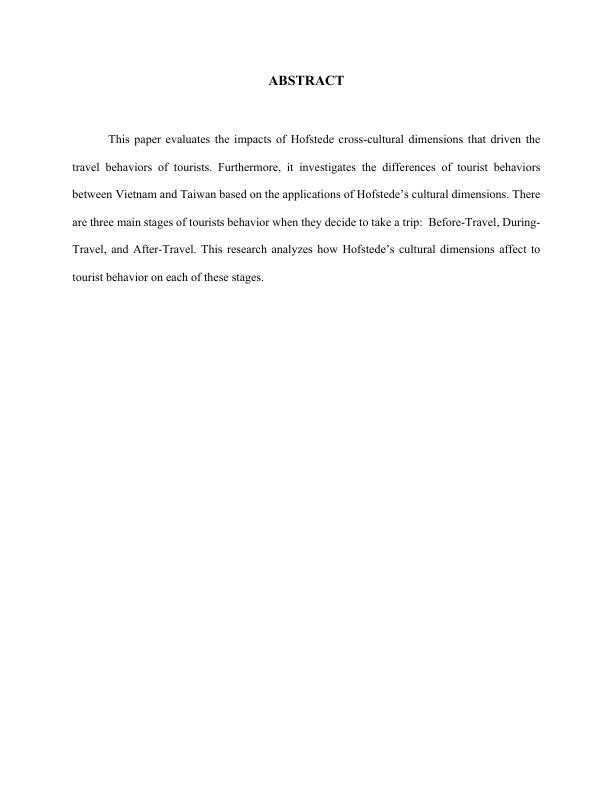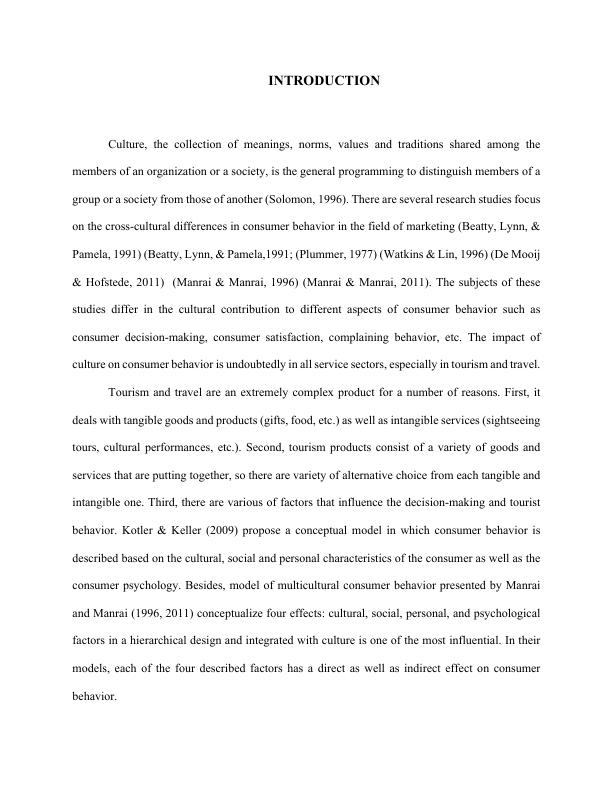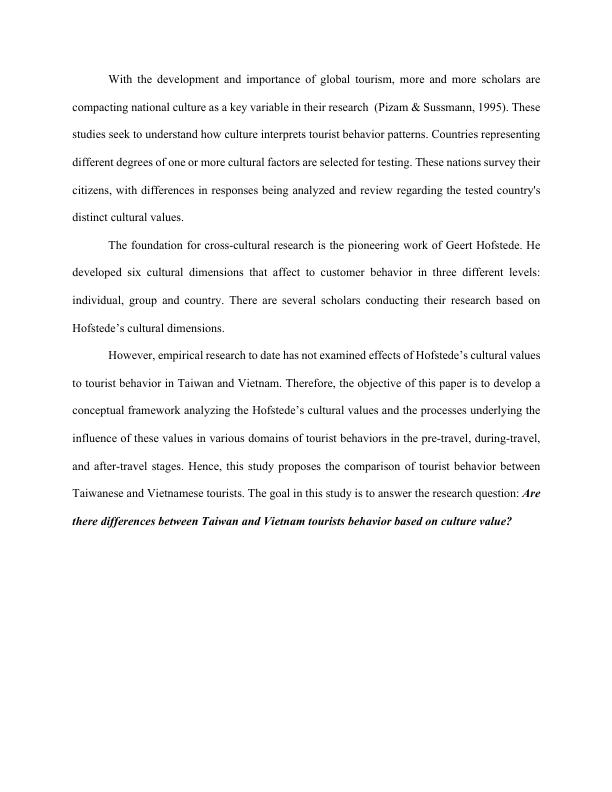Ask a question from expert
Department of Business Administration
20 Pages4986 Words143 Views
Added on 2022-01-18
Department of Business Administration
Added on 2022-01-18
BookmarkShareRelated Documents
NATIONAL YUNLIN UNIVERSITY OF
SCIENCE AND TECHNOLOGY
Department of Business Administration
CROSS CULTURAL MANAGEMENT
TERM PAPER
THE EFFECT OF CROSS-CULTURAL FACTORS ON THE
TOURIST BEHAVIOUR: A COMPARISON BETWEEN
VIETNAM AND TAIWAN TOURISTS BASED ON HOFSTEDE’S
CULTURAL DIMENSIONS
STUDENT NAME: NGUYEN DUC TAM
STUDENT ID: D10922013
SCIENCE AND TECHNOLOGY
Department of Business Administration
CROSS CULTURAL MANAGEMENT
TERM PAPER
THE EFFECT OF CROSS-CULTURAL FACTORS ON THE
TOURIST BEHAVIOUR: A COMPARISON BETWEEN
VIETNAM AND TAIWAN TOURISTS BASED ON HOFSTEDE’S
CULTURAL DIMENSIONS
STUDENT NAME: NGUYEN DUC TAM
STUDENT ID: D10922013

ABSTRACT
This paper evaluates the impacts of Hofstede cross-cultural dimensions that driven the
travel behaviors of tourists. Furthermore, it investigates the differences of tourist behaviors
between Vietnam and Taiwan based on the applications of Hofstede’s cultural dimensions. There
are three main stages of tourists behavior when they decide to take a trip: Before-Travel, During-
Travel, and After-Travel. This research analyzes how Hofstede’s cultural dimensions affect to
tourist behavior on each of these stages.
This paper evaluates the impacts of Hofstede cross-cultural dimensions that driven the
travel behaviors of tourists. Furthermore, it investigates the differences of tourist behaviors
between Vietnam and Taiwan based on the applications of Hofstede’s cultural dimensions. There
are three main stages of tourists behavior when they decide to take a trip: Before-Travel, During-
Travel, and After-Travel. This research analyzes how Hofstede’s cultural dimensions affect to
tourist behavior on each of these stages.

INTRODUCTION
Culture, the collection of meanings, norms, values and traditions shared among the
members of an organization or a society, is the general programming to distinguish members of a
group or a society from those of another (Solomon, 1996). There are several research studies focus
on the cross-cultural differences in consumer behavior in the field of marketing (Beatty, Lynn, &
Pamela, 1991) (Beatty, Lynn, & Pamela,1991; (Plummer, 1977) (Watkins & Lin, 1996) (De Mooij
& Hofstede, 2011) (Manrai & Manrai, 1996) (Manrai & Manrai, 2011). The subjects of these
studies differ in the cultural contribution to different aspects of consumer behavior such as
consumer decision-making, consumer satisfaction, complaining behavior, etc. The impact of
culture on consumer behavior is undoubtedly in all service sectors, especially in tourism and travel.
Tourism and travel are an extremely complex product for a number of reasons. First, it
deals with tangible goods and products (gifts, food, etc.) as well as intangible services (sightseeing
tours, cultural performances, etc.). Second, tourism products consist of a variety of goods and
services that are putting together, so there are variety of alternative choice from each tangible and
intangible one. Third, there are various of factors that influence the decision-making and tourist
behavior. Kotler & Keller (2009) propose a conceptual model in which consumer behavior is
described based on the cultural, social and personal characteristics of the consumer as well as the
consumer psychology. Besides, model of multicultural consumer behavior presented by Manrai
and Manrai (1996, 2011) conceptualize four effects: cultural, social, personal, and psychological
factors in a hierarchical design and integrated with culture is one of the most influential. In their
models, each of the four described factors has a direct as well as indirect effect on consumer
behavior.
Culture, the collection of meanings, norms, values and traditions shared among the
members of an organization or a society, is the general programming to distinguish members of a
group or a society from those of another (Solomon, 1996). There are several research studies focus
on the cross-cultural differences in consumer behavior in the field of marketing (Beatty, Lynn, &
Pamela, 1991) (Beatty, Lynn, & Pamela,1991; (Plummer, 1977) (Watkins & Lin, 1996) (De Mooij
& Hofstede, 2011) (Manrai & Manrai, 1996) (Manrai & Manrai, 2011). The subjects of these
studies differ in the cultural contribution to different aspects of consumer behavior such as
consumer decision-making, consumer satisfaction, complaining behavior, etc. The impact of
culture on consumer behavior is undoubtedly in all service sectors, especially in tourism and travel.
Tourism and travel are an extremely complex product for a number of reasons. First, it
deals with tangible goods and products (gifts, food, etc.) as well as intangible services (sightseeing
tours, cultural performances, etc.). Second, tourism products consist of a variety of goods and
services that are putting together, so there are variety of alternative choice from each tangible and
intangible one. Third, there are various of factors that influence the decision-making and tourist
behavior. Kotler & Keller (2009) propose a conceptual model in which consumer behavior is
described based on the cultural, social and personal characteristics of the consumer as well as the
consumer psychology. Besides, model of multicultural consumer behavior presented by Manrai
and Manrai (1996, 2011) conceptualize four effects: cultural, social, personal, and psychological
factors in a hierarchical design and integrated with culture is one of the most influential. In their
models, each of the four described factors has a direct as well as indirect effect on consumer
behavior.

With the development and importance of global tourism, more and more scholars are
compacting national culture as a key variable in their research (Pizam & Sussmann, 1995). These
studies seek to understand how culture interprets tourist behavior patterns. Countries representing
different degrees of one or more cultural factors are selected for testing. These nations survey their
citizens, with differences in responses being analyzed and review regarding the tested country's
distinct cultural values.
The foundation for cross-cultural research is the pioneering work of Geert Hofstede. He
developed six cultural dimensions that affect to customer behavior in three different levels:
individual, group and country. There are several scholars conducting their research based on
Hofstede’s cultural dimensions.
However, empirical research to date has not examined effects of Hofstede’s cultural values
to tourist behavior in Taiwan and Vietnam. Therefore, the objective of this paper is to develop a
conceptual framework analyzing the Hofstede’s cultural values and the processes underlying the
influence of these values in various domains of tourist behaviors in the pre-travel, during-travel,
and after-travel stages. Hence, this study proposes the comparison of tourist behavior between
Taiwanese and Vietnamese tourists. The goal in this study is to answer the research question: Are
there differences between Taiwan and Vietnam tourists behavior based on culture value?
compacting national culture as a key variable in their research (Pizam & Sussmann, 1995). These
studies seek to understand how culture interprets tourist behavior patterns. Countries representing
different degrees of one or more cultural factors are selected for testing. These nations survey their
citizens, with differences in responses being analyzed and review regarding the tested country's
distinct cultural values.
The foundation for cross-cultural research is the pioneering work of Geert Hofstede. He
developed six cultural dimensions that affect to customer behavior in three different levels:
individual, group and country. There are several scholars conducting their research based on
Hofstede’s cultural dimensions.
However, empirical research to date has not examined effects of Hofstede’s cultural values
to tourist behavior in Taiwan and Vietnam. Therefore, the objective of this paper is to develop a
conceptual framework analyzing the Hofstede’s cultural values and the processes underlying the
influence of these values in various domains of tourist behaviors in the pre-travel, during-travel,
and after-travel stages. Hence, this study proposes the comparison of tourist behavior between
Taiwanese and Vietnamese tourists. The goal in this study is to answer the research question: Are
there differences between Taiwan and Vietnam tourists behavior based on culture value?

End of preview
Want to access all the pages? Upload your documents or become a member.
Related Documents
Cultural Dimensions in the Hospitality Industry: A Critical Analysislg...
|10
|2416
|302
Contemporary Issues in Tourism Assignmentlg...
|9
|2000
|224